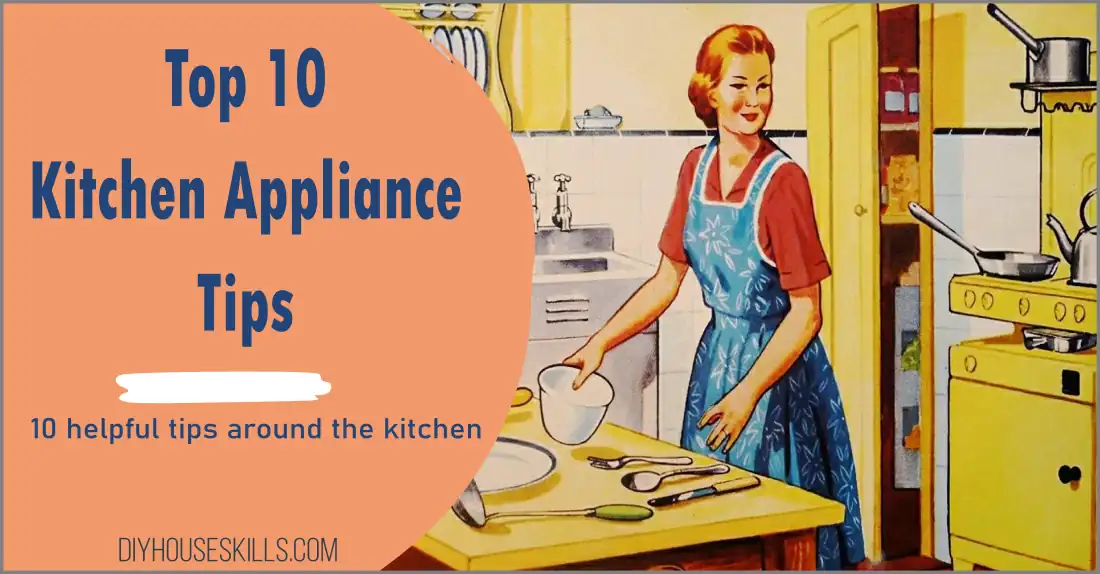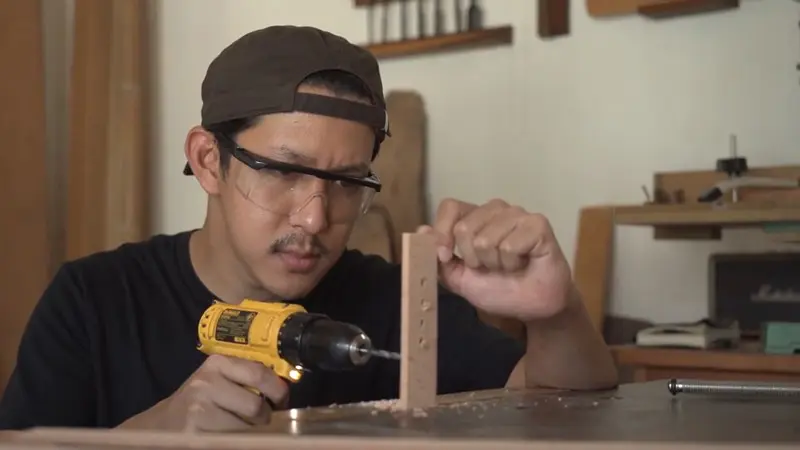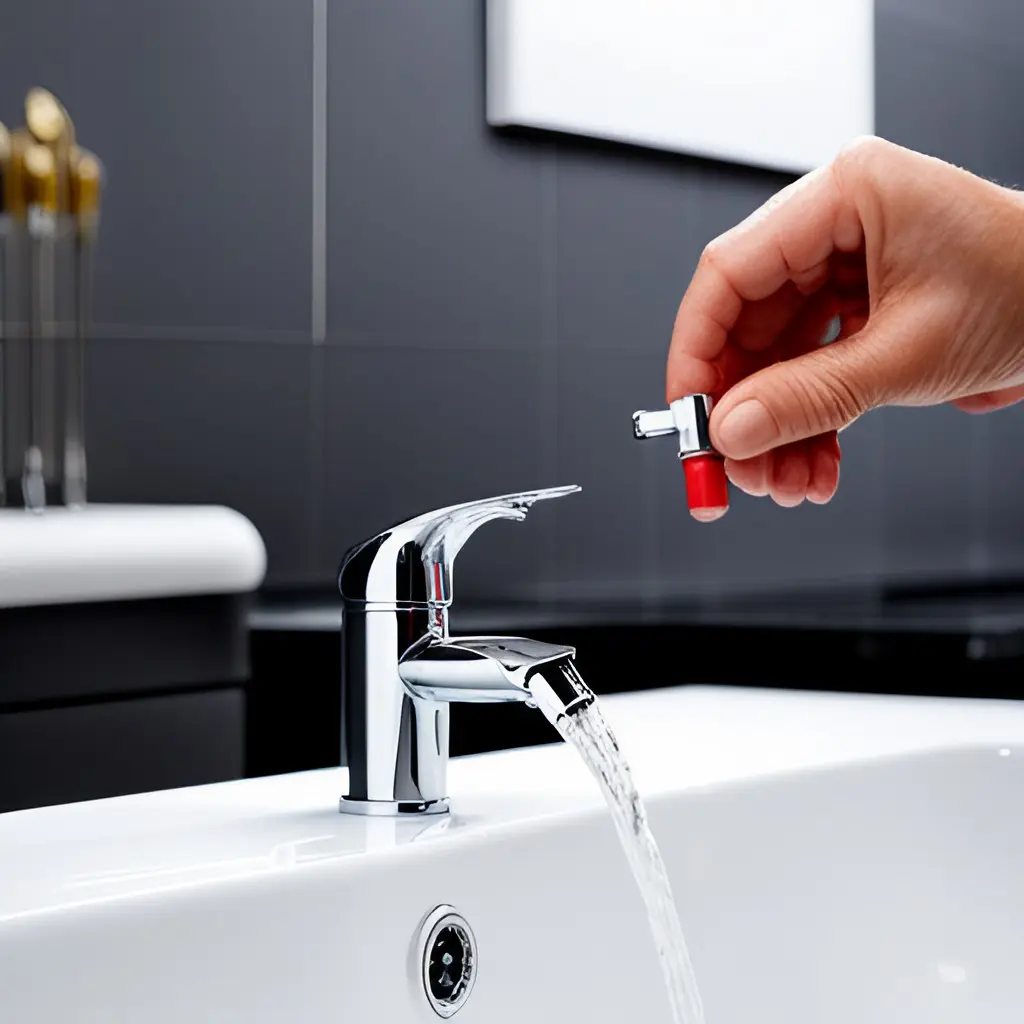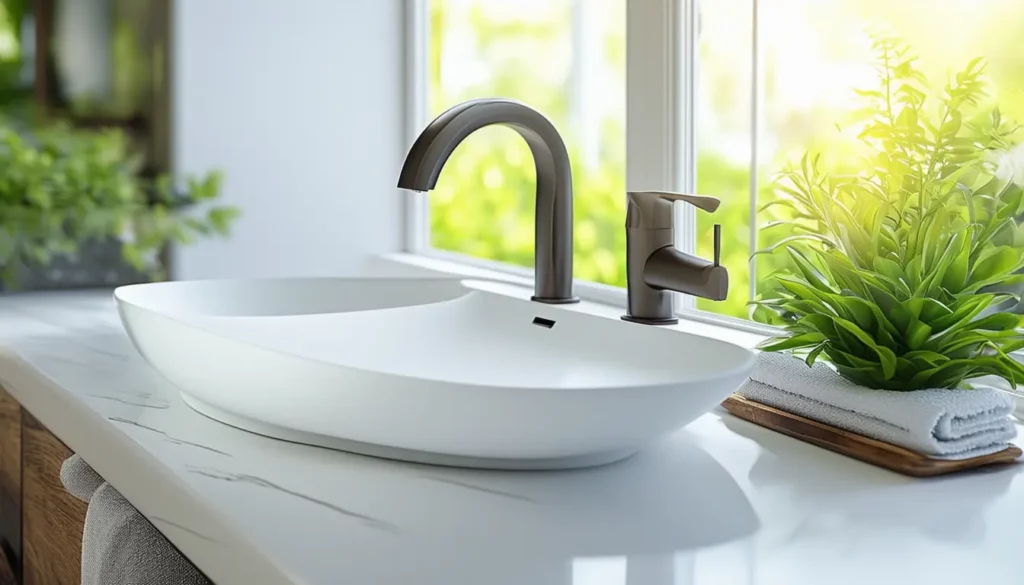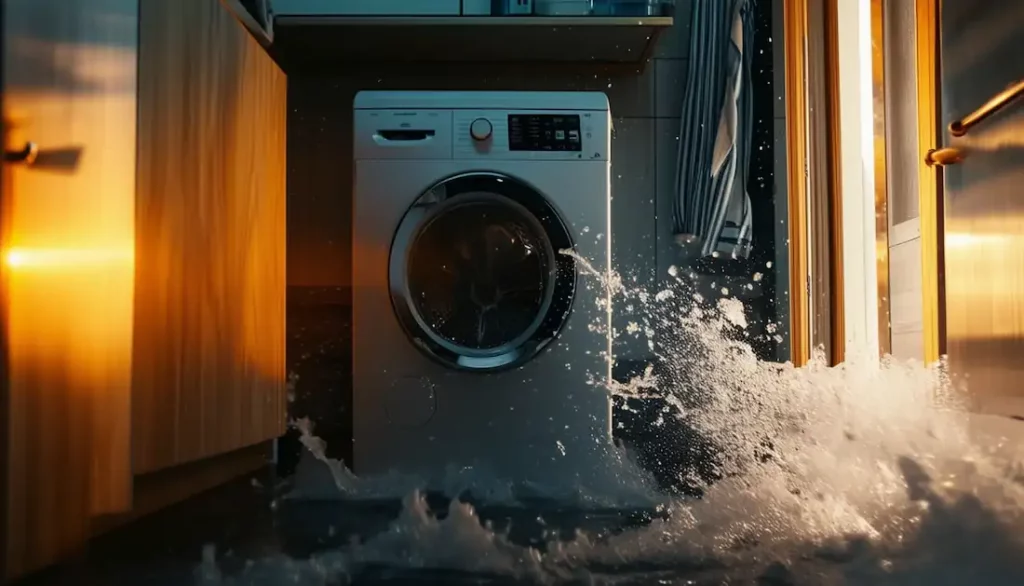Here are ten tips to help you get the most out of your kitchen appliances. Whether you’re a seasoned chef or just starting out in the kitchen, by following these simple tips, you can keep your kitchen clean and organized so that cooking is a breeze.
- 1. Keep your refrigerator clean
- 2. Don’t overfill your dishwasher
- 3. Use a microwave-safe dish when cooking in the microwave
- 4. Defrost food in the fridge overnight instead of using the microwave
- 5. Store pots and pans in cabinets with doors to save space
- 6. Invest in a quality kitchen knife set to make chopping vegetables easier
- 7. Always unplug small kitchen appliances before cleaning them
- 8. Clean up spills as soon as they happen
- 9. Recycle old kitchen appliances responsibly
- 10. Keep an updated shopping list of kitchen essentials
- Conclusion
1. Keep your refrigerator clean
Regularly wipe down the shelves and remove any expired food.
The refrigerator is one of the most important appliances in the kitchen, so it’s important to keep it clean and tidy. Here are some appliance tips to help you get started:
- Wipe down the shelves on a regular basis. This will help to remove any build-up of dirt and grime.
- Remove any expired food from the fridge. This will help to prevent spoilage and keep your food fresh.
- If there are any spills, be sure to clean them up immediately. This will help to prevent bacteria from growing.
Following these appliance tips will help you to keep your refrigerator clean and organized.
See Why Your Ice Maker’s Ice Tastes Bad: Causes and Solutions
2. Don’t overfill your dishwasher
Make sure there’s enough room for the water to circulate so that dishes come out clean.
One of the most common mistakes people make when using a dishwasher is overloading it. This can be tempting, especially if you have a lot of dishes to clean, but it significantly decreases the dishwasher’s ability to clean your dishes effectively.
When there’s not enough room for water to circulate freely, dishes aren’t as clean as they could be.
So, to get the most out of your dishwasher, make sure you don’t overfill it – there should be enough room for water to move around so that all of your dishes come out clean and sparkling.
3. Use a microwave-safe dish when cooking in the microwave
When cooking in the microwave, it is important to use a microwave-safe dish. Microwave-safe dishes are made of materials that will not be damaged by exposure to microwaves. This means that they will not melt, warp, or catch fire.
Common microwave-safe materials include glass, ceramic, and plastic. Most microwaves have a setting that will only allow microwave-safe dishes to be used. If you are unsure whether or not your dish is microwave safe, it is best to err on the side of caution and choose another option.
By taking this simple precaution, you can help to ensure that your food is cooked safely and evenly.
4. Defrost food in the fridge overnight instead of using the microwave
When it comes to defrosting food, the best method is to plan ahead and allow the food to thaw in the fridge overnight. This slow, gradual process prevents the outer layer of the food from reaching an unsafe temperature while the center is still frozen.
In contrast, when you defrost food in the microwave, there is a greater chance that bacteria will multiply. Additionally, microwaving can cause some areas of the food to start cooking while others are still frozen, which can lead to uneven texture and flavor.
So next time you need to defrost something, take it out of the freezer in advance and let it thaw in the fridge overnight. Your food will be safer and tastier as a result.
5. Store pots and pans in cabinets with doors to save space
When it comes to storing pots and pans, there are two main options: cabinets with doors and open shelves.
Both have their pros and cons, but ultimately it comes down to personal preference. If you’re short on space, cabinets with doors can help to free up some room in your kitchen. They keep pots and pans out of sight, which can make your kitchen feel more spacious and organized.
Plus, it’s easy to grab what you need without having to search through a stack of pans. On the other hand, open shelves can provide easier access to your pots and pans. And if you have a collection of beautiful cookware, it can be nice to display it in an organized way.
Ultimately, the best option for storing pots and pans is the one that works best for your kitchen layout and your personal preferences.
Check out my Laundry Room Organization Tips.
6. Invest in a quality kitchen knife set to make chopping vegetables easier
Anyone who has ever chopped vegetables knows that it can be a tedious and time-consuming task. A good kitchen knife set can make the process easier and more efficient. A quality set will include a variety of knives of different sizes and shapes to suit any chopping need.
For example, a paring knife is perfect for slicing small items like garlic cloves, while a chef’s knife is better suited for larger tasks like chopping onions.
In addition, a sharp knife will make it easier to cut through tough veggies like carrots and celery. Investing in a good kitchen knife set is essential for any home cook who wants to make quick work of chopping vegetables.
7. Always unplug small kitchen appliances before cleaning them
Small kitchen appliances like toasters and blenders should always be unplugged before cleaning them. This basic safety precaution helps to prevent electric shocks or fires from occurring, as the appliance will not be able to draw any power when it is unplugged.
Additionally, many small kitchen appliances have removable parts that can be washed in the sink or dishwasher. This can help to keep your appliances clean and free of germs, while also extending their lifespan.
So next time you need to clean your small kitchen appliances, make sure to unplug them first. It’s a simple step that could save you from serious injury or property damage down the line.
8. Clean up spills as soon as they happen
Spills in the kitchen can quickly become sticky messes if not attended to right away. To avoid this, always take action immediately when a spill occurs.
Use a damp cloth or paper towel to soak up any liquid and then follow up with a dry cloth to remove any residue. This will help to keep your countertops and floors clean and prevent bacteria from growing.
Additionally, spills can also be cleaned up quickly with a solution of water and dish soap. Just make sure to use the right cleaner for your kitchen surfaces; some materials like marble or granite may require special cleaning products.
Cleaning up spills as soon as they happen is an essential part of keeping your kitchen in top condition.
9. Recycle old kitchen appliances responsibly
When it comes time to upgrade your kitchen appliances, you’ll need to do something with the old ones first. Rather than throwing them away in the trash, try recycling them instead.
Many local governments offer free recycling services for small appliances such as microwaves, toasters, blenders, and more. You can also call your local landfill or trash pickup service to find out if they offer a special pickup for large appliances such as ovens and refrigerators.
By recycling your old kitchen appliances responsibly, you’ll be doing your part to help protect the environment.
10. Keep an updated shopping list of kitchen essentials
Keeping track of all the ingredients, tools and other items that you need in the kitchen can be tricky. To make sure you always have what you need on hand, create a shopping list of essential items like spices, oils, and cooking utensils so that you never run out.
Additionally, this list can also include items like paper towels, dish soap, and other cleaning supplies that aren’t perishable.
Having an updated shopping list on hand can help to make your grocery trips more efficient and keep your kitchen stocked with all the basics.
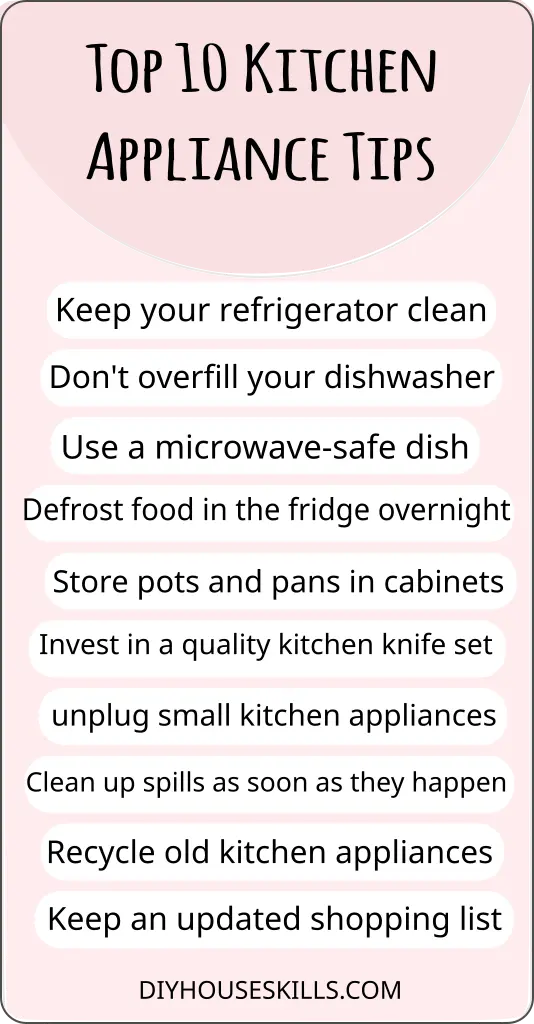
Conclusion
When it comes to kitchen appliances, there are a few essentials that every home cook should have. Do you have any other tips for keeping a clean and tidy kitchen?
- Mastering the Power Drill: Tips for Effective & Safe UseFor DIY enthusiasts and novices, the power drill is a formidable ally, capable of transforming the most mundane tasks into victorious feats of creativity and precision. Whether you’re a novice just starting your DIY journey or a seasoned enthusiast looking to refine your skills, this guide offers a tailored experience for every skill level. Select … Read more
- Fixing Leaky Faucets: A Step-by-Step GuideWe’ve all been there, listening to that relentless dripping, watching our water bill inch up, and wondering how much it’s going to cost to get it fixed this time. But hey, what if I told you that you don’t need a plumbing degree to tackle this issue? That’s right! I’m here to walk you through … Read more
- Change Your Bathroom Sink Faucet The Easy WayGive Your Bathroom a Mini-Makeover! Isn’t it amazing how something as simple as changing your bathroom sink faucet can completely revamp the room’s vibe? If you’re itching for a little upgrade but don’t want to commit to a full-blown renovation, you’re in the right place. We’ve got the perfect project for you. Armed with a … Read more
- Your Guide to DIY Door Handle ReplacementTackle your next DIY project with confidence by learning how to replace a door handle with this comprehensive guide. We break down the process into manageable steps and provide useful tips and warnings to ensure your success. Firstly, it’s important to understand that not all door handles are the same. Your door’s backset – the … Read more
- Washer Won’t Drain Water – How to Troubleshoot and FixImagine this: you’re in the middle of a laundry marathon, and just as you’re about to cross the finish line, your trusty washer decides it’s had enough and refuses to drain. Understanding the common causes and step-by-step solutions can empower you to fix the issue with confidence and precision. This guide provides an authoritative, detailed, … Read more

